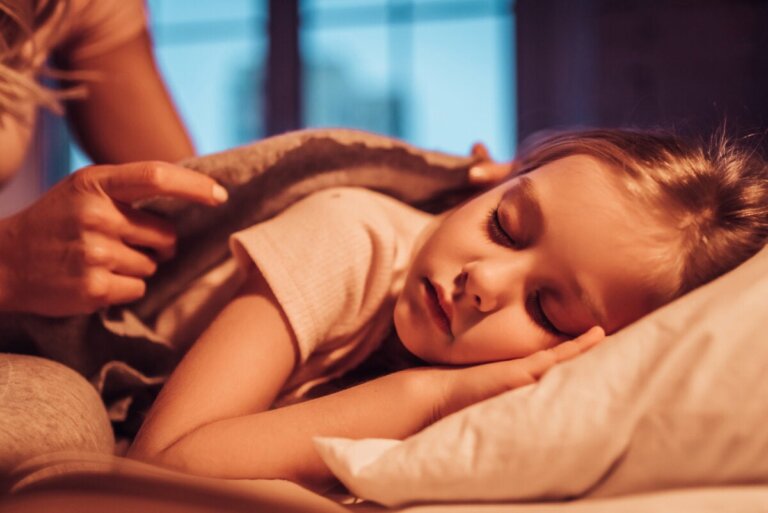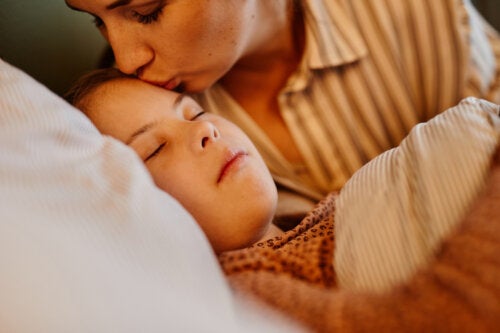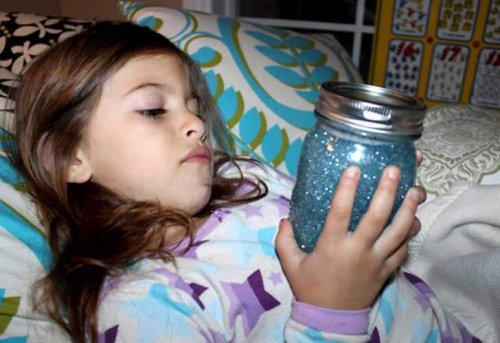5 Guided Meditation Techniques to Help Kids Sleep Better


Written and verified by the psychologist Sharon Capeluto
Guided meditation for children doesn’t have to be complicated, extensive, or formal. In fact, practices with a creative and entertaining approach can be applied to make this experience engaging and beneficial for children, especially at bedtime.
Incorporating playful elements, such as cute characters, imaginative stories, or simple games, will allow children to engage in the exercises in a more authentic and spontaneous way. Take note of the following ideas!
Guided meditation techniques to help children sleep better
In a guided meditation for children, the guide provides verbal instructions that help little ones relax, concentrate, and visualize specific images or thoughts. This allows them to reach a state of calm that’s ideal for falling asleep and enjoying a restful sleep.
Do you think you need to be a meditation expert to implement these strategies? Nothing could be further from the truth! You can explore audios that are available on platforms such as YouTube that offer such methods or create your own sessions tailored to your child’s interests.
We can’t expect children to relax on their own or to be interested in following boring and serious instructions. The key is to apply entertaining techniques, and believe me, it’s not as hard as it sounds! Often, adding a simple game or telling a short story with animated characters is enough to spark their enthusiasm. Check out these exercises.
1. The Koeppen Technique

This is an adaptation of the Jacobson relaxation method that we adults often use. Instead of conventional and serious instructions, the Koeppen technique includes games and imagination and is ideal for children to learn to recognize their own bodies. Through simple and attractive instructions, we help children to tense and relax their muscles.
A lemon for hands and arms
“Imagine you are holding a lemon in your hand. Squeeze it hard to extract all its juice. Feel your muscles tighten as you do so. Open your hand slowly and pretend to let go of the lemon. Now, do the same with your other hand.
Lazy cat for arms and shoulders.
“Now you are a lazy cat stretching after a nap. Extend your front paws (arms) up over your head and bring them back to stretch your shoulders. Then let go to relax.
Hidden turtle for shoulders and neck
“You’re a turtle who’s very comfortable lying in the sun. Suddenly, you hear a loud noise that startles you – you have to hide in your shell! Hide your head and bring your shoulders to your ears… Now, the danger is gone. You can come out.”
Giant chewing gum for the jaw
“Imagine you’re chewing a giant stick of gum. You need to use all the muscles in your mouth to chew it. Open and close your mouth over and over again, with strength.”
An annoying fly for the face
“You’re very calm when suddenly, an annoying fly lands on your nose. Without using your hands, wrinkle your nose as hard as you can to shoo it away… The fly is gone, you can relax now.”
An elephant for the abdomen
“Imagine you’re resting in the sun. Suddenly, you notice an elephant running toward you. To protect yourself, you need to stay still. Tense your stomach as if you were a rock… The elephant is going the other way. You can relax your abdomen now.”
Mud for legs and feet
“You’re walking in the countryside when you come across a muddy pond. The mud is up to your knees. Try to push your feet and legs out of it. You’ve done it!”
It’s important that the child performs several repetitions of each exercise. Also, the instructions can be adapted according to what each child likes, so it’s more fun!
2. A guided gratitude meditation for children
Teaching children to be grateful is fundamental to their well-being, and a gratitude routine at night can be very valuable in this process. The ritual is simple, just do the following:
- Find a quiet place.
- Ask the child to close their eyes.
- Breathe deeply to create a relaxed atmosphere.
- Guide them through pleasant thoughts:
- “Think about the things that make you feel happy and grateful in your life.”
- “It can be your family, your friends, your favorite toys, or anything else that makes you smile.”
This guided meditation helps children focus on the positive and cultivate an optimistic attitude.
3. Balloon Technique
The balloon metaphor is ideal for introducing children to the practice of mindful breathing and thus helping them calm down and reduce stress before bedtime.
You can tell them to imagine that inside their belly is a balloon and that they should slowly blow it up. As air goes in, the balloon slowly expands. “Take a deep breath in, filling the balloon, and then gently exhale, letting the air out of the balloon.” Repeat this process several times until your child reaches a calm state.
4. Calm down jar

Many times, children come into the evening with emotions boiling over. This may be because they’ve had a tantrum a while ago, they’re angry, or they’re just bursting with energy and want to keep playing.
In this context, a calm jar becomes your best ally. Although it’s not classified as a typical guided meditation technique, it’s a simple but effective tool for calming children’s minds.
It consists of a “magic jar” with water and glitter that, when shaken, represents how our emotions can be revved up. But, when left still, the glitter gradually settles, showing how calm returns to our minds.
This simple but powerful technique provides children with a visual representation of how agitated emotions can calm down over time, offering a tangible tool for managing their emotional state before bedtime.
5. The Five Senses Method
Another guided meditation exercise to induce children into a peaceful sleep is the Five Senses Method, which works like a sensory walk to help them relax. To begin, ask your child to close their eyes and take several deep breaths. Then, invite them to a game where they should look for and mention the following:
- Five objects they can see around them, such as a stuffed animal, the lamp, or the curtains.
- Four textures they can feel, either the coolness of the sheets or the softness of the pillow.
- Three sounds they can hear, such as the whisper of the wind outside or the hum of the fan.
- Two scents they can smell, whether it’s the scent of the cologne they’re wearing or even the smell of your clothes.
- One taste they can savor. Encourage them to think of a taste they like, such as chocolate, a fruit, or toothpaste.
To conclude this guided meditation, you can tell your child that after exploring their five senses and immersing themself in this sensory experience, they now have the opportunity to let go of any thoughts or worries that may be on their mind. Finally, encourage them to carry these calm sensations with them as they prepare to enjoy a restful sleep.
The value of mindfulness for children
Mindfulness encompasses a set of techniques designed to foster awareness in the present moment. Guided meditation, one of these techniques, can be very useful for children to focus on specific aspects of their experience, such as breathing, physical sensations, or emotions.
Several studies support the multiple benefits of this practice. According to a paper entitled “The Role of Psychology Today“, children who incorporate mindfulness on a regular basis experience improvements in sleep, greater concentration, and increased self-confidence. What’s more, they also develop skills to regulate their emotions. In addition, this practice helps reduce stress and anxiety.
Be sure to create a relaxing environment
Relaxing in a noisy, stimulus-filled environment is difficult enough. In order for children to take full advantage of the benefits of guided meditation, it’s crucial to create a conditioned environment that creates a peaceful atmosphere.
Consider dimming the lights and eliminating any disturbing or intrusive sounds. You may even choose to play soft, soothing music. Also, turn off electronic devices to avoid distractions and allow for a total disconnection before going to bed.
Guided meditation for children doesn’t have to be complicated, extensive, or formal. In fact, practices with a creative and entertaining approach can be applied to make this experience engaging and beneficial for children, especially at bedtime.
Incorporating playful elements, such as cute characters, imaginative stories, or simple games, will allow children to engage in the exercises in a more authentic and spontaneous way. Take note of the following ideas!
Guided meditation techniques to help children sleep better
In a guided meditation for children, the guide provides verbal instructions that help little ones relax, concentrate, and visualize specific images or thoughts. This allows them to reach a state of calm that’s ideal for falling asleep and enjoying a restful sleep.
Do you think you need to be a meditation expert to implement these strategies? Nothing could be further from the truth! You can explore audios that are available on platforms such as YouTube that offer such methods or create your own sessions tailored to your child’s interests.
We can’t expect children to relax on their own or to be interested in following boring and serious instructions. The key is to apply entertaining techniques, and believe me, it’s not as hard as it sounds! Often, adding a simple game or telling a short story with animated characters is enough to spark their enthusiasm. Check out these exercises.
1. The Koeppen Technique

This is an adaptation of the Jacobson relaxation method that we adults often use. Instead of conventional and serious instructions, the Koeppen technique includes games and imagination and is ideal for children to learn to recognize their own bodies. Through simple and attractive instructions, we help children to tense and relax their muscles.
A lemon for hands and arms
“Imagine you are holding a lemon in your hand. Squeeze it hard to extract all its juice. Feel your muscles tighten as you do so. Open your hand slowly and pretend to let go of the lemon. Now, do the same with your other hand.
Lazy cat for arms and shoulders.
“Now you are a lazy cat stretching after a nap. Extend your front paws (arms) up over your head and bring them back to stretch your shoulders. Then let go to relax.
Hidden turtle for shoulders and neck
“You’re a turtle who’s very comfortable lying in the sun. Suddenly, you hear a loud noise that startles you – you have to hide in your shell! Hide your head and bring your shoulders to your ears… Now, the danger is gone. You can come out.”
Giant chewing gum for the jaw
“Imagine you’re chewing a giant stick of gum. You need to use all the muscles in your mouth to chew it. Open and close your mouth over and over again, with strength.”
An annoying fly for the face
“You’re very calm when suddenly, an annoying fly lands on your nose. Without using your hands, wrinkle your nose as hard as you can to shoo it away… The fly is gone, you can relax now.”
An elephant for the abdomen
“Imagine you’re resting in the sun. Suddenly, you notice an elephant running toward you. To protect yourself, you need to stay still. Tense your stomach as if you were a rock… The elephant is going the other way. You can relax your abdomen now.”
Mud for legs and feet
“You’re walking in the countryside when you come across a muddy pond. The mud is up to your knees. Try to push your feet and legs out of it. You’ve done it!”
It’s important that the child performs several repetitions of each exercise. Also, the instructions can be adapted according to what each child likes, so it’s more fun!
2. A guided gratitude meditation for children
Teaching children to be grateful is fundamental to their well-being, and a gratitude routine at night can be very valuable in this process. The ritual is simple, just do the following:
- Find a quiet place.
- Ask the child to close their eyes.
- Breathe deeply to create a relaxed atmosphere.
- Guide them through pleasant thoughts:
- “Think about the things that make you feel happy and grateful in your life.”
- “It can be your family, your friends, your favorite toys, or anything else that makes you smile.”
This guided meditation helps children focus on the positive and cultivate an optimistic attitude.
3. Balloon Technique
The balloon metaphor is ideal for introducing children to the practice of mindful breathing and thus helping them calm down and reduce stress before bedtime.
You can tell them to imagine that inside their belly is a balloon and that they should slowly blow it up. As air goes in, the balloon slowly expands. “Take a deep breath in, filling the balloon, and then gently exhale, letting the air out of the balloon.” Repeat this process several times until your child reaches a calm state.
4. Calm down jar

Many times, children come into the evening with emotions boiling over. This may be because they’ve had a tantrum a while ago, they’re angry, or they’re just bursting with energy and want to keep playing.
In this context, a calm jar becomes your best ally. Although it’s not classified as a typical guided meditation technique, it’s a simple but effective tool for calming children’s minds.
It consists of a “magic jar” with water and glitter that, when shaken, represents how our emotions can be revved up. But, when left still, the glitter gradually settles, showing how calm returns to our minds.
This simple but powerful technique provides children with a visual representation of how agitated emotions can calm down over time, offering a tangible tool for managing their emotional state before bedtime.
5. The Five Senses Method
Another guided meditation exercise to induce children into a peaceful sleep is the Five Senses Method, which works like a sensory walk to help them relax. To begin, ask your child to close their eyes and take several deep breaths. Then, invite them to a game where they should look for and mention the following:
- Five objects they can see around them, such as a stuffed animal, the lamp, or the curtains.
- Four textures they can feel, either the coolness of the sheets or the softness of the pillow.
- Three sounds they can hear, such as the whisper of the wind outside or the hum of the fan.
- Two scents they can smell, whether it’s the scent of the cologne they’re wearing or even the smell of your clothes.
- One taste they can savor. Encourage them to think of a taste they like, such as chocolate, a fruit, or toothpaste.
To conclude this guided meditation, you can tell your child that after exploring their five senses and immersing themself in this sensory experience, they now have the opportunity to let go of any thoughts or worries that may be on their mind. Finally, encourage them to carry these calm sensations with them as they prepare to enjoy a restful sleep.
The value of mindfulness for children
Mindfulness encompasses a set of techniques designed to foster awareness in the present moment. Guided meditation, one of these techniques, can be very useful for children to focus on specific aspects of their experience, such as breathing, physical sensations, or emotions.
Several studies support the multiple benefits of this practice. According to a paper entitled “The Role of Psychology Today“, children who incorporate mindfulness on a regular basis experience improvements in sleep, greater concentration, and increased self-confidence. What’s more, they also develop skills to regulate their emotions. In addition, this practice helps reduce stress and anxiety.
Be sure to create a relaxing environment
Relaxing in a noisy, stimulus-filled environment is difficult enough. In order for children to take full advantage of the benefits of guided meditation, it’s crucial to create a conditioned environment that creates a peaceful atmosphere.
Consider dimming the lights and eliminating any disturbing or intrusive sounds. You may even choose to play soft, soothing music. Also, turn off electronic devices to avoid distractions and allow for a total disconnection before going to bed.
All cited sources were thoroughly reviewed by our team to ensure their quality, reliability, currency, and validity. The bibliography of this article was considered reliable and of academic or scientific accuracy.
- Álvarez, A. A., & Quiroz, P, C. (2021). Desarrollo emocional. Regulación emocional, en niños y niñas de 4 a 5 años, por medio de la Técnica de Koeppen. [Tesis de grado. Licenciatura en Educación. Escuela de Educación Parvularia]. Santiago, Chile.
- Crescentini, C., Capurso, V., Furlan, S., & Fabbro, F. (2016). Mindfulness-oriented meditation for primary school children: Effects on attention and psychological well-being. Frontiers in psychology, 7, 1-12. https://www.ncbi.nlm.nih.gov/pmc/articles/PMC4894866/
- Comas, S. (2016). Burbujas de paz: pequeño libro de Mindfulness para niños (y no tan niños). Nube de Tinta.
- Garey, J. (s.f.). The Power of Mindfulness. Child Mind Institute. Consultado el 1 de noviembre de 2023. https://childmind.org/article/the-power-of-mindfulness/
- Pacheco S, D. I., Canedo G, A., Manrique A, A., & García S, J. N. (2018). Mindfulness: atención plena en educación infantil. El Papel de la Psicología Hoy. https://dehesa.unex.es/handle/10662/16136
- Pardina L, I. (2017). Gestión del comportamiento en el aula de Educación infantil. [Tesis de grado. Facultad de Educación de Segovia. Universidad de Valladolid]. Archivo digital. https://uvadoc.uva.es/handle/10324/24203
- William, M., & Sheils, K. (2020). 101 Mindfulness Games For Happy Minds: For Children Aged 3-7. https://www.rutherfordhouseschool.co.uk/wp-content/uploads/2021/01/101-mindfulness-games-for-happy-minds-for-children-aged-3-7.pdf
This text is provided for informational purposes only and does not replace consultation with a professional. If in doubt, consult your specialist.








